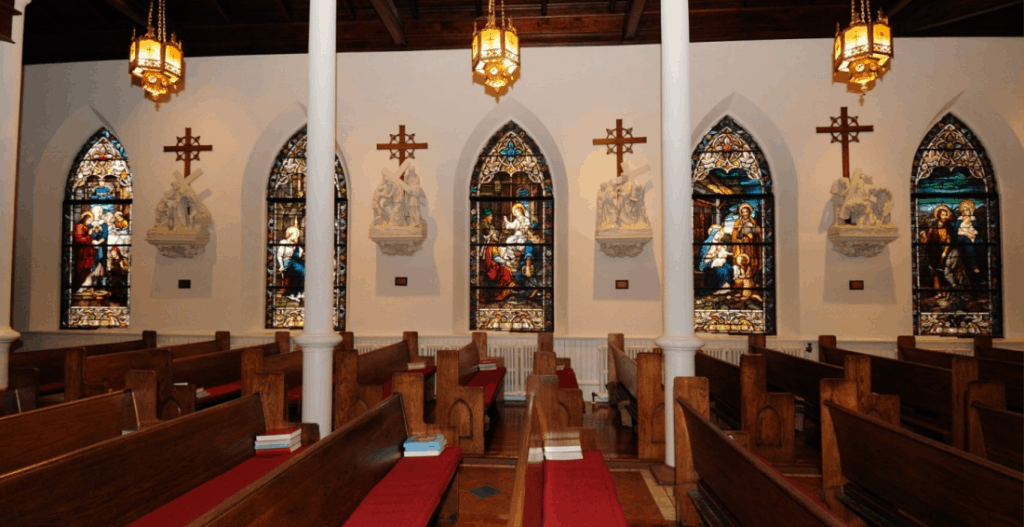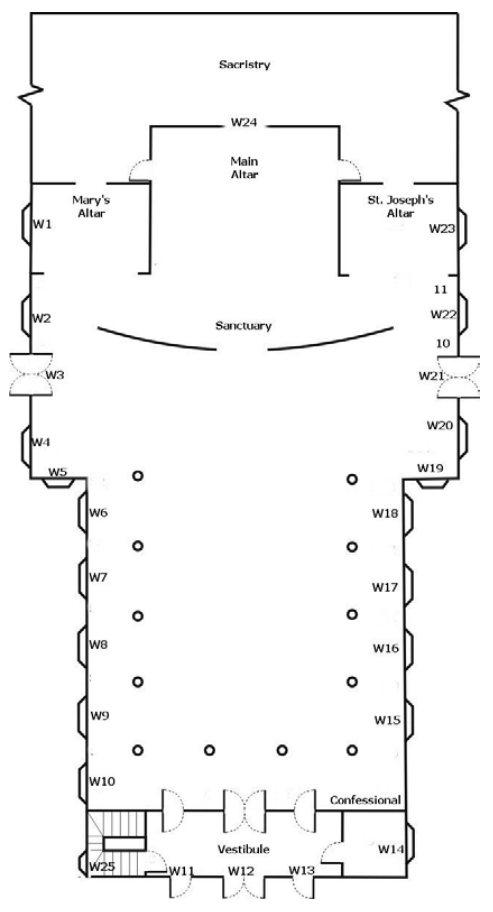Stained Glass Windows

During the pastorate of Father Robert Fullerton (1904-1926), twenty-four magnificent stained glass windows were installed in St. Michael’s Church and, collectively, form one of the artistic treasures of Pensacola. The windows were designed and produced by Emil Frei, whose work is recognized as an unsurpassed example of the Munich Style of Pictorial Stained Glass. The Bavarian-born Frei studied at the Munich School of Fine Arts before immigrating to the United States in the 1890s. In 1898 he opened the Emil Frei Art Glass Company in St. Louis and was quickly recognized for his talent and skill. Frei created his masterpieces from lead crystal glass painted, detailed and fired to create strong, vibrant, high translucency colors with subtle gradations of hues and textures. So detailed is the painting in the Munich Pictorial style that many artists spent their entire careers painting nothing but faces, while others would specialize in garments, backgrounds, etc. Also very prominent in the Munich style is the background which frames the central image, known as the “architectural canopy”, meant to reflect the actual architecture of the church.
In anticipation of the 130th anniversary of the June 6th, 1886 dedication of this church, St. Michael undeertook a project to restore these windows to their original beauty following years of hurricane damage, vandalism and deterioration. With generous donations from our parishioners and from the community, and with the award of a matching grant from the Florida Department of State, Division of Historical Resources, we were fortunate to secure the services of the original firm of Emil Frei.
High resolution photos of these windows (before restoration) are available for viewing and/or download in our Photo Gallery.
The cruciform shape of St. Michael’s Church creates focal areas and each area, by its architectural form and orientation to the sun, contributes to the development of certain ideas. The traditional function or purpose of stained glass in church windows was to enhance the celebration and environment by surrounding the rite with appropriate color, light and content. The color and light change from the rising sun to the setting sun while the message contained in their content remains the same: Jesus’ birth, life, death and resurrection, which is the basis of the Eucharistic Liturgy.

The south transept windows of the church focus on Mary, the Mother of Jesus. On the south side of the minor altar of the Blessed Virgin the window depicts the Assumption of Mary (W1). Next are windows depicting events leading up to Jesus’ birth: the Annunciation (W2) by the angel Gabriel and the Visitation (W4) by Mary to her cousin Elizabeth. The Birth of Jesus (W3) is shown in the large gable window above the south door.
Continuing along the south wall toward the Narthex door, Jesus’ life as a child and young adult is portrayed: Flight into Egypt (W6), the Holy Family (W7), Jesus Preaching in the Temple (W8), Saint Joseph’s Carpenter Shop (W9) and the Wedding Feast at Cana (W10).
Major events in Jesus’ adult life are depicted on the north wall: Christ Calling His First Disciples (W15), Transfiguration (W16), Adulteress Anointing Jesus’ Feet(W17), and Jesus Raising Jairus’ Daughter (W18).
The final activities in Jesus’ life are in the north transept windows and begin with Jesus Entering Jerusalem (W20), the event which begins Holy Week and culminates in The Resurrection (W21) shown in the large gable window above the north door. One of the final activities in Jesus life is evident in the window where Jesus Gives Peter the Keys to the Kingdom (W22).
On the north side of the minor altar of Saint Joseph is Saint Joseph with Rod and Lilies (W23). High above the altar at the west end of the church is a smaller gable window with the Eucharistic Symbols of the Body and Blood (W24).
At the east end of the church, above the choir loft, is the rose window of Saint Michael the Archangel (W12), patron of Saint Michael Parish and the Diocese of Pensacola-Tallahassee. The windows of Saint Gregory the Great (W11) and King David (W13) are on either side of the rose window but are not visible from the body of the church.
Additionally, there are two narrow stained glass windows, which obviously held personal meaning for the Irishman, Father Fullerton, a member of the St. Aloysius Society. Best viewed from the perspective of the altar, the window of St. Patrick (W5) is behind the last pew in the south arm of the church and the window of St. Aloysius (W19) is behind the last pew in the north arm of the church.
In 1954 a stained-glass window summarizing the Apostles Creed (W14) was designed by the Rambusch Company of New York. This was installed in the vesting room, located in the northeast end of the church, and is visible from the vestibule.
